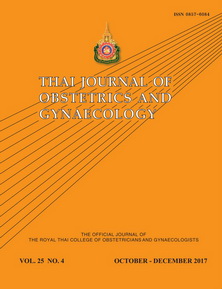Short-term Changes in Quality of Life among Women Who had Hysterectomy for Benign Indications at Young Age: A preliminary study
Main Article Content
Abstract
Objectives: The objective of this study was to compare the quality of life scores between younger (≤ 45 years old) and older women (≥ 46 years old) who underwent hysterectomy for benign indications.
Materials and Methods: A prospective cohort study was performed at a tertiary hospital over a 12-week period. Younger and older women who underwent elective hysterectomy for benign indications were selected as study and control groups, respectively. Quality of life was measured using the Malay version of the World Health Organisation Quality of Life Assessment-BREF questionnaire. The difference in quality of life scores from pre-surgery to 12 weeks post-hysterectomy between the two age groups were measured using repeated-measures analysis of variance (ANOVA).
Results: A total of 18 women were enrolled in the study group and 45 in the control group. Except for the environment domain among control group, all other domains showed an improvement in quality of life scores. However, the group–time interaction of the repeated-measures ANOVA showed no difference in quality of life score changes of all domains between younger and older women following hysterectomy.
Conclusion: In this preliminary study, younger women demonstrated comparable quality of life scores at 12 weeks after hysterectomy in comparison with older women. The results of this study may assist the gynaecologist and patient during pre-surgery counselling
Keywords: hysterectomy, women, quality of life, analysis of variance, leiomyoma
Article Details
References
2. Merrill RM. Hysterectomy surveillance in the United States, 1997 through 2005. Med Sci Monit 2008;14:CR24-31.
3. Wright JD, Herzog TJ, Tsui J, Ananth CV, Lewin SN, Lu Y-S, et al. Nationwide trends in the performance of inpatient hysterectomy in the United States. Obstet Gynecol 2013;122:233-41.
4. Sanei-Moghaddam A, Ma T, Goughnour SL, Edwards RP, Lounder PJ, Ismail N, et al. Changes in hysterectomy trends after the implementation of a clinical pathway. Obstet Gynecol 2016;127:139-47.
5. Lai JC-Y, Huang N, Huang S-M, Hu H-Y, Wang C-W, Chou Y-J, et al. Decreasing trend of hysterectomy in Taiwan: a population-based study, 1997–2010. Taiwan J Obstet Gynecol 2015;54:512–8.
6. Sardeshpande NN. Hysterectomy among premenopausal women and its’ impact on their life - Findings from a study in rural parts of India. Int Res J Soc Sci 2015;4:15-22.
7. Cooper R, Mishra G, Hardy R, Kuh D. Hysterectomy and subsequent psychological health: findings from a British birth cohort study. J Affect Disord 2009;115:122-30.
8. Yeh JS, Cheng H-M, Hsu P-F, Sung S-H, Liu W-L, Fang H-L, et al. Hysterectomy in young women associates with higher risk of stroke: a nationwide cohort study. Int J Cardiol 2013;168:2616-21.
9. Julious SA. Sample size of 12 per group rule of thumb for a pilot study. Pharm Stat 2005;4:287-91.
10. Hasanah CI, Naing L, Rahman AR. World Health Organization Quality of Life Assessment: brief version in Bahasa Malaysia. Med J Malaysia 2003;58:79-88.
11. Development of the World Health Organization WHOQOL-BREF quality of life assessment. The WHOQOL Group. Psychol Med 1998;28:551-8.
12. Ciarmela P, Ciavattini A, Giannubilo SR, Lamanna P, Fiorini R, Tranquilli AL, et al. Management of leiomyomas in perimenopausal women. Maturitas 2014;78:168-73.
13. Pazzaglia E, Praet J, Vandromme J, Rozenberg S. Medical or surgical management of fibroids? An internet survey of gynaecologists’ views. Maturitas 2017;95:6-10.
14. Entwistle V, Williams B, Skea Z, MacLennan G, Bhattacharya S. Which surgical decisions should patients participate in and how? Reflections on women’s recollections of discussions about variants of hysterectomy. Soc Sci Med 2006;62:499-509.
15. Sharma JB, Malhotra M, Gupta S, Kumar A, Singh BP, Vindal A. A preliminary survey of patients’ views on awareness, information, choices and expectations in women undergoing hysterectomy. J Indian Med Assoc 2004;102:304-6,308.
16. Kuppermann M, Varner RE, Summitt RL, Learman LA, Ireland C, Vittinghoff E, et al. Effect of hysterectomy vs medical treatment on health-related quality of life and sexual functioning: the medicine or surgery (Ms) randomized trial. JAMA 2004;291:1447-55.
17. Kjerulff KH, Rhodes JC, Langenberg PW, Harvey LA. Patient satisfaction with results of hysterectomy. Am J Obstet Gynecol 2000;183:1440-7.
18. Nieboer TE, Johnson N, Lethaby A, Tavender E, Curr E, Garry R, et al. Surgical approach to hysterectomy for benign gynaecological disease. Cochrane Database Syst Rev 2009;3:CD003677.
19. Wright KN, Jonsdottir GM, Jorgensen S, Einarsson JI. A Comparison of abdominal, laparoscopic, vaginal, and robotic hysterectomies: surgical outcomes and operative cost in a single institution. J Minim Invasive Gynecol 2010;17:S23.
20. Cohen SM, Linenberger HK, Wehry LE, Welz HK. Recovery after hysterectomy: a year-long look. Webmed Central Obstet Gynaecol 2011;2:WMC001761.


